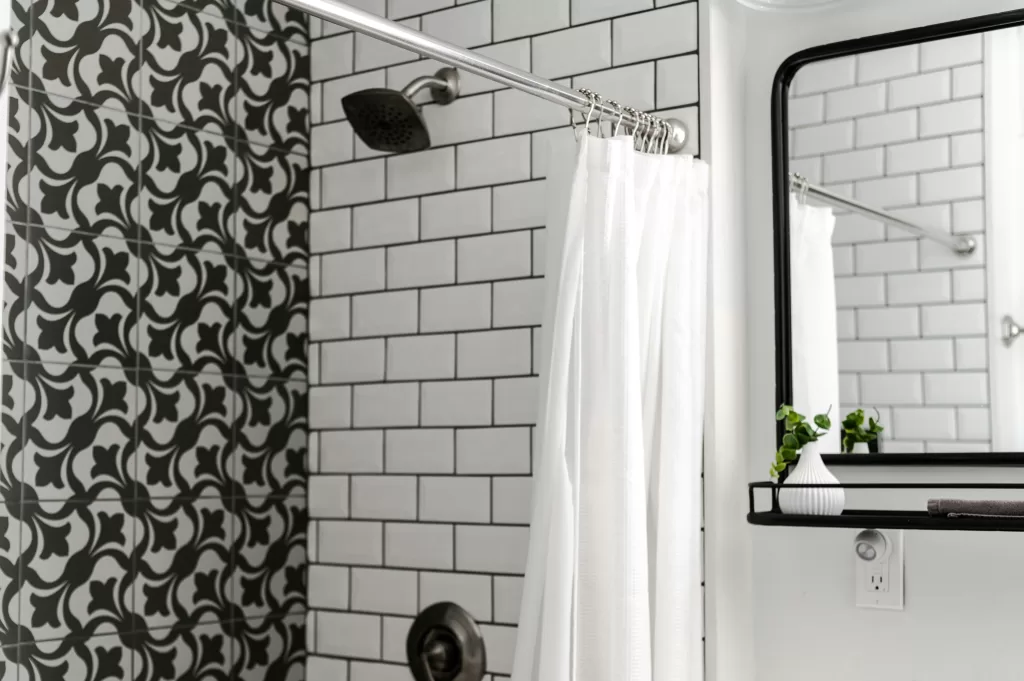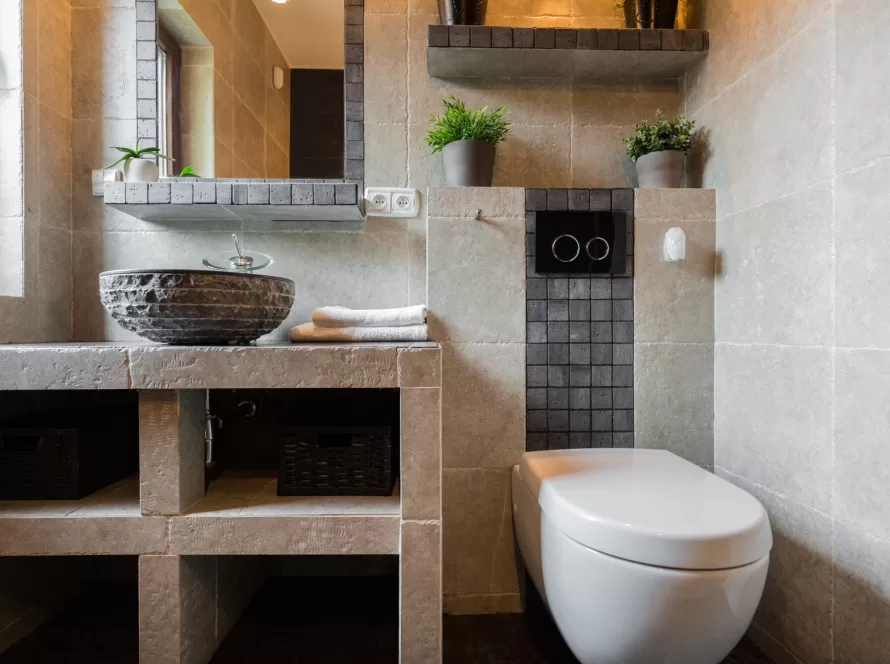Tiling plays a crucial role in bathrooms, providing both functionality and aesthetics. Tiles help protect surfaces from water damage and create a clean, stylish look that enhances the overall appeal of the space.
When considering the average cost to tile a shower or bathroom, it’s essential to understand the various factors that influence expenses. Factors such as the type of tile material, design preferences, bathroom size, and labor costs all contribute to the overall cost of the tiling project
In this blog post, we will look at the average cost to tile a shower or bathroom. We’ll also highlight how, by partnering with Alpha Living, you can find the perfect contractor to match your budget and design needs. Let’s get started with this guide to tile installation and its average costs in 2024.
What is the Average Cost to Tile a Shower or Bathroom?
What is the average cost of retiling a bathroom? Well, the typical expense ranges from $12.50 to $25 per square foot, averaging around $2,000 for the entire project.
This cost covers materials and labor. Of course, the price varies based on factors like the type of tile material chosen, the complexity of the design, and the size of the bathroom.
For instance, ceramic tiles may range from $1 to $30 per square foot, while marble tiles can cost between $3 and $50 per square foot. The design pattern, such as straight set or mosaic, also affects the overall cost. Additionally, larger bathrooms generally incur higher expenses compared to smaller ones.
Labor costs, which typically range from $7 to $14 per square foot, constitute a significant portion of the total expenditure. By understanding these cost factors, homeowners can better estimate and plan for their bathroom retiling projects.
What Are the Cost Factors of Tiling?
When considering a bathroom renovation involving tiling, understanding the cost factors is essential for effective budgeting. Several key elements influence the total expense, ranging from the type of tile materials chosen to the size of the area to be tiled. Let’s explore these factors in more detail below.
Type of Tile Materials
The choice of tile material can greatly impact the overall cost of the project. Different materials have different price ranges and maintenance requirements.
For example, ceramic tiles, ranging from $1 to $30 per square foot as noted above, offer versatility and affordability, while marble tiles, priced between $3 and $50 per square foot, provide luxury but require more maintenance.
Tile Design and Patterns
The design and pattern of the tiles can also affect the total cost of tiling a bathroom. Complex patterns or intricate designs may require more time and effort to install, resulting in higher labor costs.
Simple designs like straight set or running bond are generally more affordable, while decorative borders or diagonal layouts may add to the overall expenses.
Labor Costs
Labor costs constitute a significant portion of the total expenditure for tiling projects. Professional installers typically charge between $7 to $14 per square foot, with rates varying based on factors such as the complexity of the design and the skill level required.
Delicate materials or intricate patterns may incur higher labor charges due to the additional time and expertise needed for installation.
Additional Materials
In addition to tile materials and labor, there are various additional materials required for tiling projects, including grout, adhesive, and sealant.
The cost of these materials can add up, particularly for larger or more intricate projects. It’s essential to factor in these expenses when budgeting for a bathroom tiling project to ensure an accurate estimate of the total cost.
Size of the Area to be Tiled
The size of the area to be tiled directly influences the overall cost of the project. Larger bathrooms or shower spaces will require more materials and labor, resulting in higher expenses.
Conversely, smaller bathrooms may incur lower costs. It’s important to accurately measure the square footage of the tiling area and consider this when estimating the total project cost.
Exploring Common Tile Materials for Bathrooms
When planning a bathroom tiling project, choosing the right tile material is crucial for achieving both aesthetic appeal and functionality. Each type of tile material comes with its own set of pros and cons, impacting factors such as durability, maintenance, and cost. Let’s explore the most common tile materials used in bathrooms and discuss their advantages and disadvantages.
Ceramic Tile
Ceramic tiles are a popular choice for bathrooms due to their versatility and affordability. They come in a wide range of colors, patterns, and textures, allowing for endless design possibilities.
However, ceramic tiles are relatively softer than other materials and may chip or crack under heavy impact. While durable, they may not be as long-lasting as some other options, especially in high-traffic areas. Additionally, unglazed ceramic tiles can absorb stains, requiring more frequent cleaning and maintenance.
Porcelain Tile
Porcelain tiles are known for their durability and water resistance, making them a popular choice for bathroom floors and walls. Made from denser clay and fired at higher temperatures than ceramic tiles, porcelain tiles are highly durable and impervious to water. They are extremely durable and resistant to chips, scratches, and stains, making them suitable for high-traffic areas.
However, porcelain tiles tend to be more expensive than ceramic tiles due to their manufacturing process and durability. Their installation can also be more challenging due to their weight and hardness.
Natural Stone Tile
Natural stone tiles, such as marble, travertine, and slate, add elegance and sophistication to bathroom spaces. Each type of natural stone offers unique colors, patterns, and textures, creating a luxurious ambiance. Natural stone tiles exude natural beauty and elegance, adding value to any bathroom design.
However, they require regular sealing and maintenance to prevent staining, etching, and water damage. Natural stone tiles are among the most expensive options and may absorb liquids, leading to staining or discoloration if not properly sealed.
Marble Tile
Marble tiles are synonymous with luxury and elegance, making them a popular choice for upscale bathroom designs. With their unique veining patterns and natural beauty, marble tiles add a timeless and sophisticated touch to any bathroom space.
Marble is a porous material and so requires regular sealing to prevent staining and water damage. Additionally, marble tiles are among the most expensive options, making them less budget-friendly compared to ceramic or porcelain tiles.
Glass Tile
Glass tiles are renowned for their sleek and modern appearance, making them a stylish choice for contemporary bathroom designs. Available in various colors, shapes, and finishes, glass tiles can create stunning visual effects and add depth to bathroom walls and backsplashes.
While glass tiles are resistant to moisture and easy to clean, they can be more fragile and prone to scratches compared to other materials. Additionally, glass tiles tend to be more expensive than ceramic or porcelain tiles, making them a premium option for bathroom tiling projects.
Design Considerations for Tiled Spaces

In this section, we’ll delve into crucial factors for designing tiled spaces. We’ll explore selecting appropriate tile sizes, colors, and patterns, as well as tips for creating visual interest and cohesion. These insights will help you craft stunning and functional tiled areas in your home, whatever your budget.
Selecting Tile Sizes, Colors, and Patterns
Choosing the right tile sizes, colors, and patterns is essential for creating visually appealing and functional tiled spaces. In bathrooms, larger tiles can make small spaces appear larger, while smaller tiles can add texture and detail to larger areas. Light-colored tiles can brighten up dark bathrooms, while darker tiles can create a cozy ambiance.
Additionally, selecting the appropriate tile pattern, such as straight set, herringbone, or basketweave, can enhance the overall aesthetic of the space and complement other design elements.
Considering Tile Layout and Design
To create visual interest and cohesion in tiled spaces, consider incorporating accent tiles or borders to break up large expanses of tile and add personality to the room.
Mixing different tile sizes, colors, and patterns can create dynamic visual effects and add depth to the design. Additionally, paying attention to grout color and spacing can further enhance the overall look of the tiled space.
Examples of Popular Tile Designs
Popular tile designs include subway tiles, hexagon tiles, and mosaic tiles, each offering unique visual appeal and versatility. Subway tiles are timeless and versatile, making them suitable for both traditional and modern bathroom designs.
Hexagon tiles add a touch of retro charm and can create interesting geometric patterns on floors and walls. Mosaic tiles come in a variety of colors and materials and are perfect for adding intricate details and accents to shower walls, backsplashes, and other tiled surfaces.

Find Professional Tile Installation Near You

Compare Quotes from Top-rated Bathroom Remodel contractors in your area.
So, while the average cost to tile a shower or bathroom can vary based on factors such as materials, size, and labor rates, homeowners can typically expect to budget anywhere from $2,000 to $5,000 for the entire project.
If you’re ready to start on your bathroom renovations project, consider using Alpha Living. Through our portal, homeowners can connect with professional contractors tailored to their needs, simply by entering their zip code. Let us guide you toward your dream tiled space today.





Facebook
Comments